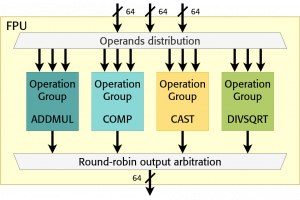Difference between revisions of "Integrating an Open-Source Double-Precision Floating-Point DivSqrt Unit into CVFPU (1S)"
From iis-projects
Lbertaccini (talk | contribs) |
Lbertaccini (talk | contribs) |
||
| (4 intermediate revisions by the same user not shown) | |||
| Line 7: | Line 7: | ||
[[Category:2023]] | [[Category:2023]] | ||
[[Category:Semester Thesis]] | [[Category:Semester Thesis]] | ||
| − | [[Category: | + | [[Category:Completed]] |
[[Category:Lbertaccini]] | [[Category:Lbertaccini]] | ||
= Overview = | = Overview = | ||
| − | == Status: | + | == Status: Completed == |
* Type: Semester Thesis (1 or 2 students) | * Type: Semester Thesis (1 or 2 students) | ||
| + | * Student: Roman Marquart | ||
* Professor: Prof. Dr. L. Benini | * Professor: Prof. Dr. L. Benini | ||
* Supervisors: | * Supervisors: | ||
| Line 58: | Line 59: | ||
| − | ===Status: | + | ===Status: Completed === |
Latest revision as of 15:40, 15 February 2024
Contents
Overview
Status: Completed
- Type: Semester Thesis (1 or 2 students)
- Student: Roman Marquart
- Professor: Prof. Dr. L. Benini
- Supervisors:
Introduction
Floating-point (FP) arithmetic is fundamental for a large set of applications spanning from high-performance computing to neural network training. A flexible highly-parametrized open-source floating-point unit (FPU) called FPnew (today known as CVFPU) [1,2] has been developed at IIS.
FPnew is optimized for high-performance and energy efficiency. It is internally organized in modules, each one carrying out one operation group (add/mul, divsqrt, cast, comparisons, dot-product).
Recently, T-Head open sourced a set of processors. The goal of this project is to evaluate the double-precision DivSqrt unit included in the open-source T-head OpenC910 [3] processor and integrate it into CVFPU.
Project
- Investigation of the T-Head OpenC910 FP DivSqrt module and its fundamental blocks
- RTL integration of T-Head OpenC910 FP DivSqrt module into CVFPU
- Evaluation of the FP DivSqrt module and the enhanced CVFPU
Project Breakdown
- 20% Architecture review
- 40% RTL implementation
- 40% Evaluation
Prerequisites
- Strong interest in computer architecture
- Experience with digital design in SystemVerilog as taught in VLSI I
- Experience with ASIC implementation flow (synthesis) as taught in VLSI II
References
[1] Mach, S., Schuiki, F., Zaruba, F., & Benini, L. (2020). FPnew: An Open-Source Multiformat Floating-Point Unit Architecture for Energy-Proportional Transprecision Computing. IEEE Transactions on Very Large Scale Integration (VLSI) Systems, 29(4), 774-787. (https://ieeexplore.ieee.org/abstract/document/9311229)
[2] https://github.com/openhwgroup/cvfpu
[3] https://github.com/T-head-Semi/openc910
